Multiple Studies Say Cultural Heritage at Risk Because of Climate Change
In several articles newly published in the journal Antiquity, archaeologists from around the world are sounding the alarm to alert policy makers to the threat posed to humanity’s collective cultural heritage by the unfolding climate crisis. The publishing of these papers coincides with the opening of the 2022 United Nations Climate Change Conference (COP27), which will officially convene on November 6 in Sharm El Sheikh, Egypt.
If nothing is done, the archaeologists warn, an almost unimaginable quantity of incredibly valuable ruins and artifacts may be damaged or lost—and the impact could be felt soon.
One of the new papers was written by Dr. Jargen Hollesen, an archaeologist affiliated with the National Museum of Denmark.
“Climate change is accelerating, amplifying existing risks and creating new ones, the consequences of which could be devastating for the archaeological record,” Dr. Hollesen explained in an Antiquity press release. “However, from a global perspective, very little is being done to protect the archaeological record from climate change.”
The archaeologists whose papers appear in Antiquity represent multiple countries, all of which are threatened by climate change to one degree or another. In all of these locations heritage sites both discovered and still hidden are at risk, from forces that are beyond the capacity of archaeologists to control.
- Drought Stones Pass Messages of Warning to Europeans
- Sahara Climate Change Linked to 1000-Year Southeast Asian Megadrought
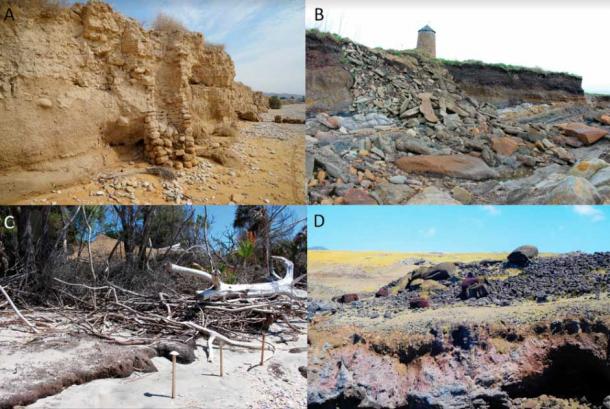
Examples of archaeological sites impacted by coastal erosion: A) the base of Siraf’s old city walls on the Persian Gulf of Iran (photograph by M. Pourkerman); B) St Monans, Scotland (photograph by T. Dawson); C) a beach in South Carolina, USA (photograph by T. Dawson); and D) Ahu Akahanga, Rapa Nui (photograph by J. Downes). (Antiquity Publications Ltd)
Wetlands Washouts Threaten Our Heritage
Wetlands that produce conditions ideal for the preservation of ancient artifacts or human and animal specimens are under risk from climate change. Rising sea levels may flood them out or severe drought conditions that dry them up, depending on where they are located.
In Denmark, the Tolland Man is perhaps the most important find ever to be recovered from a wetland. The Tolland Man lived more than 2,000 years ago, but his body was so well preserved by its entombment in a bog that it looked like it might have been buried just a few years earlier.
“Archaeological finds show how organic materials can be preserved for millennia in wetlands,” said Professor Henning Matthiesen, who is also from the National Museum of Denmark and who co-authored another Antiquity paper detailing the heritage-related dangers of climate change. Matthiesen pointed out the nearly half the world’s wetlands have already been lost, mainly to development and urban sprawl. Climate change will only exacerbate this disturbing trend, he said, and since wetlands sequester carbon their loss could actually speed up the process of CO2 accumulation in the atmosphere.
Researchers are already seeing the effects of this dynamic in action. In Somerset, England, wetland water levels at the Glastonbury Lake Village site, which was once the home of an Iron Age (800 BC to 43 AD) settlement, have declined by nearly one-third of a meter in just the last four years. Dry conditions aren’t good for ancient artifacts, which can decay more quickly in the open air, meaning archaeologists there could be in a race against time to recover as much as they can before things start turning to dust.
- Less Ice and Low Water Levels Reveal Hidden Treasures – At A Price
- Record UK Drought Exposes Ancient Sunken Village and Bridge
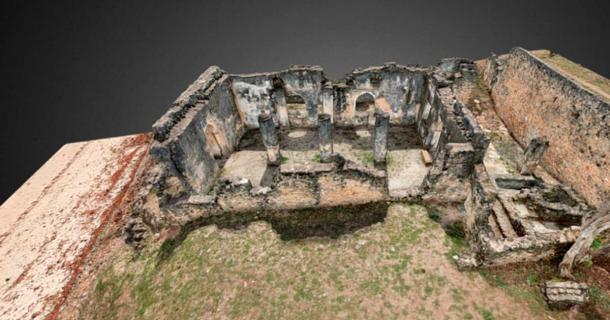
3D model of the Malindi Mosque, Kilwa Kisiwani, Tanzania. Sea-level rise and loss of mangroves, which act as a buffer to the sea, have resulted in the site experiencing loss of the seaward side of the monument (collected by CyArk and distributed by Open Heritage 3D: https://artsandculture.google.com/project/heritage-on-the-edge). (Antiquity Publications Ltd)
Underwater Archaeology Under Siege
Like inland wetlands, the world’s oceans are also threatened by climate change. An international team of marine archaeologists who published another paper in Antiquity outline some of the troubles that alterations in global climate may cause.
These researchers analyzed decades of research that has looked into the impact of climate change on underwater archaeological sites. What they uncovered, they assert, is ominous.
“Climate change is now acting as an accelerator, meaning that decisions need to be taken more quickly, and working in partnerships is essential,” said study co-author Dr. Tom Dawson, an archaeologist from the University of St. Andrews in Scotland.
The fears include the possibility that rising water temperatures, plus increased acidification of ocean water from additional carbon dioxide absorption, will cause the rapid decay of artifacts that are still on the bottom of the sea.
Still another problem is the expected increase in severe weather events that is expected to accompany climate change. These terrible storms may damage shipwrecks and other artifacts that are presently safe and protected where they are.
The latter is not a hypothetical concern. In 2015, a large typhoon in the Northern Mariana Islands badly damaged multiple Second World War shipwrecks. And there is no telling how many undiscovered shipwrecks and associated artifacts may have been buried or destroyed by similar storms.
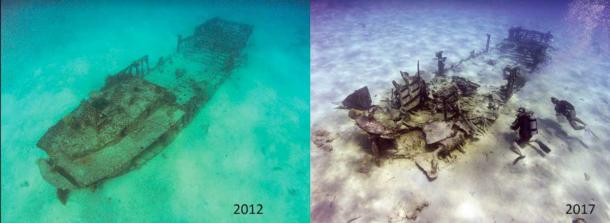
Daihatsu landing craft in Saipan in 2012 vs 2017 (after super typhoon Soudelor hit the Philippines and Saipan in 2015) (photographs by J. Carpenter, Western Australian Museum). (Antiquity Publications Ltd)
“You don’t know what you’ve got ‘til it’s gone,” stated Professor David Gregory, an archaeologist from the National Museum of Denmark who participated in the same study as Dr. Dawson. “On the one hand, UNESCO argues that underwater cultural heritage should be preserved in situ on the seabed, but is this always realistic?”
The trend of leaving undersea wreckage where it is has been hailed as a positive development in most quarters. But that choice could ultimately doom a lot of the most popular underwater sites around the world.
“Practical action is required to save something of those sites that have been placed on endangered heritage lists,” Dr. Dawson declared, as he is convinced the results will be disastrous if no action is taken soon.
Climate Change Adaptation Plans Neglecting Culture
While there’s always a chance it will be too little, too late, governments around the globe are developing plans to manage the consequences of climate change. But very few have figured out strategies to protect archaeological sites. The problem seems to be especially acute in low- and middle-income countries.
In another Antiquity paper, a team of academics led by Dr. Cathy Daly from the University of Lincoln in the United Kingdom wrote about their review of United Nations-registered climate adaptation plans of countries that belong in the low or middle-income category.
There are 154 such countries in the world. Yet only 30 had actually filed climate-change-related plans, and only 17 of these included cultural heritage and archaeological protection in their adaptation schemes. Of this group, only four—Colombia, Nigeria, Thailand, and Iran—were able to identify specific actions being taken to protect cultural treasures.
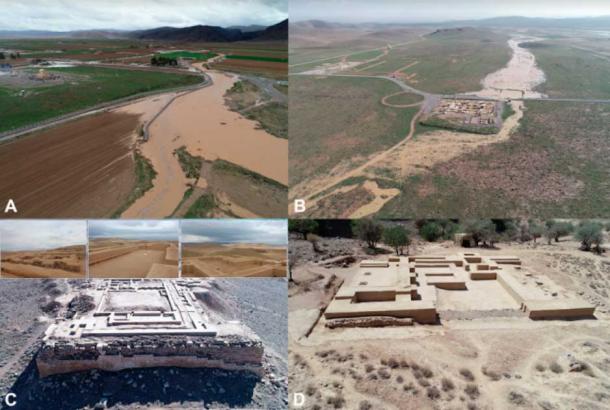
A & B) River and surface waterflooding at Pasargadae World Heritage Site in 2019, and adaptation of earthen structures at Tal-e Takht (C) and at Tang-e Bolaghipavilion (D) (photographs by M. Hosseini). (Antiquity Publications Ltd)
“In addition to overcoming financial barriers and a lack of recognition of cultural heritage and archaeological sites in climate change adaption policy, those working with cultural heritage and archaeological sites must now seek actively to address the apparent gaps in knowledge and practice,” the study authors wrote, summarizing the reasons why climate adaptation plans appear to be neglecting cultural issues.
“Climate change adaptation is essential but the heritage sector has been slow to engage with this,” Dr. Daly confirmed. “The limited amount of literature that exists on the subject is mostly focused on Europe and North America.”
The Voices in the Wilderness are Getting Louder
Determined not to be voices crying in the wilderness, the archaeologists responsible for the flurry of Antiquity papers purposefully timed the release of their studies to capture the attention of government representatives attending the COP27 conference. Their warning message is equally directed at media representatives sent there to cover the conference.
Whether this coordinated campaign to get cultural heritage protection added to the climate change agenda is successful remains to be seen. But if it fails, the consequences could be dire.
Top image: Argali sheep remains emerge from a melting glacier at Tsengel Khairkha, western Mongolia, a site that has yielded evidence of high-altitude hunting over more than three millennia (photographs by W. Taylor and P. Bittner). Source: Antiquity Publications Ltd
By Nathan Falde
















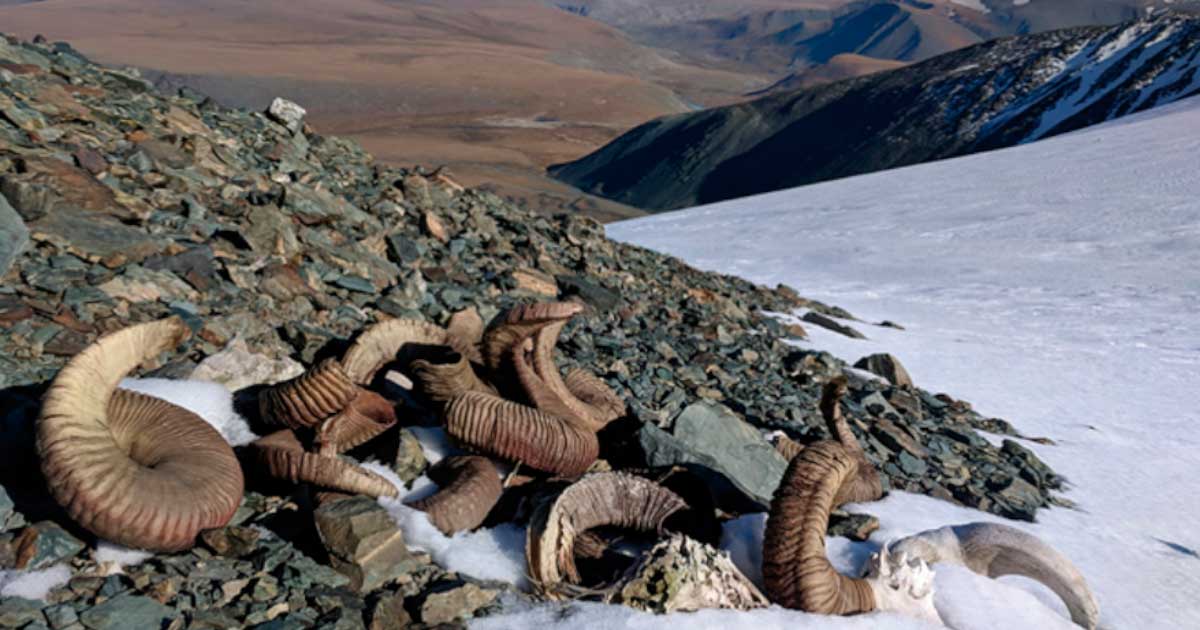

Comments
In Victoria, Australia, a supposedly eco-friendly politician has brought in new rules that one cannot step off a path in a nature park, of which there are enough to cover Wales more than twice over.
This is not to the protect the environment. It is to condition people to the removal of basic human rights, including the right to even engage in citizen science, in noticing a unknown plant species or somesuch and alerting botanists to it. Those who routinely champion saving new species and protecting human rights think this is fine.
There is a word for that. It's called 'brainwashing'.
Multiple studies can all have the same bias, be controlled by the same global mega-money and be as completely false as each other.
I'm biased. I don't like the Satanists who run climate science, pulling the Swedish elf's strings, making an aging repeat English doomsayer the saint he palpably isn't and conning environmentalists that the rubbish that eco-academia teaches is actual conservation, unlike practical things that I undertake on my farm regularly.
But you know what? It's easier just to believe in the eco-fairies than to be a true conservationist, because the latter gets you few likes on Twitter.
The author of this piece may be well-meaning, but it isn't mean to say this article is quite simply clueless. If the truth finally comes out, there's going to be a lot of eco-zombies struggling to come to terms with the fact that the people they thought were saving the planet from big companies were actually pushing it towards being enslaved by them.
So we should try to stop the planet from returning to the state it was in, naturally, before the event that caused the Ice Age? Why again?
Nobody gets paid to tell the truth.